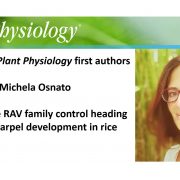
Recognizing Plant Physiology authors: Michela Osnato
Plant Physiology, Plant Physiology: Author ProfilesMichela Osnato, first author of Genes of the RAV family control heading date and carpel development in rice
Current Position: science communication manager (@secretlifeofaplantbiologist), member of the Plantae fellow program
Education: MS in Plant Biotechnology and PhD in Plant biology and crop productivity…
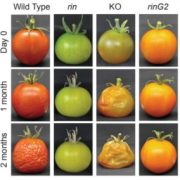
Modifying ripening through modular transcription
Plant Physiology, Plant Physiology: News and Views, ResearchSophia G. Zebell
Howard Hughes Medical Institute, Cold Spring Harbor Laboratory, Cold Spring Harbor, NY, USA
Manipulation of ripening, the process that turns hard, flavorless green tomatoes (Solanum lycopersicum) into the juicy, aromatic red fruits enjoyed worldwide, is of particular commercial…
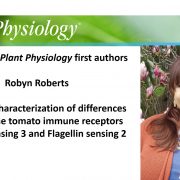
Recognizing Plant Physiology authors: Robyn Roberts
Plant Physiology, Plant Physiology: Author ProfilesRobyn Roberts, first author of Molecular characterization of differences between the tomato immune receptors Flagellin sensing 3 and Flagellin sensing 2
Current Position: Postdoctoral Scientist at the Boyce Thompson Institute. Starting in August 2020 I will be an Assistant Professor at Colorado State…
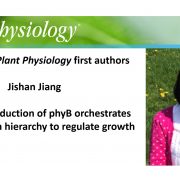
Recognizing Plant Physiology authors: Jishan Jiang
Plant Physiology, Plant Physiology: Author ProfilesJishan Jiang, first author of Retrograde induction of phyB orchestrates ethylene-auxin hierarchy to regulate growth
Current Position: Candidate for a tenure track faculty position, college of Grassland Science and Technology at China Agricultural University, Beijing, China
Education: Ph.D; Forage…
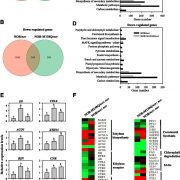
Sulfoxidation of NON-RIPENING Affects Tomato Fruit Ripening
Plant Physiology, Plant Physiology: On The InsideTranscription factors (TFs) can be subject to multiple posttranslational modifications (PTMs) that affect protein stability, subcellular localization, interactions with corepressors and activators, and DNA binding activity of TFs, thereby influencing their regulatory activities on target genes. Recent…
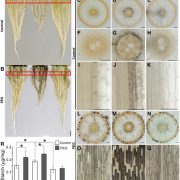
An Intrinsically Disordered Protein Interacts with the Plant Cytoskeleton
Plant Physiology, Plant Physiology: On The InsideIntrinsically disordered proteins lack a defined three-dimensional structure but often contain a simple amino acid composition with repeated sequences that provide the basis for multivalent intermolecular interactions. Because of their unique structural flexibility, conformational adaptability, and…
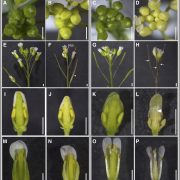
A Peptide Hormone Receptor Controls Seed Size and Yield
Plant Physiology, Plant Physiology: On The InsideLeucine-rich repeat receptor-like kinases (LRR-RLK) are one of the largest gene families in plants. Research over the past decade has implicated LRR-RLKs and their selective interactions with secreted peptide hormones in a myriad of developmental processes. A conserved LRR-RLK with a burgeoning list…
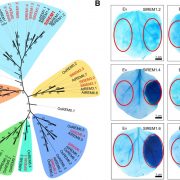
Remorin and Plant Death
Plant Physiology, Plant Physiology: On The InsideProgrammed cell death (PCD) in plants is closely associated with a wide variety of biological processes, including cell differentiation, aleurone layer formation, tapetum degradation, leaf and fruit resistance, pathogen invasion and abiotic stresses. Plant PCD is a complex genetically programmed mechanism,…

Roots, Bacteria, Ethylene, and Rhizosheath Formation
Plant Physiology, Plant Physiology: On The InsideThe rhizosheath, the sticky part of the rhizosphere, is the layer of soil that adheres to roots upon excavation of the root system. The stickiness of the layer arises from mucilage and other substances secreted by roots, soil microbes or both. Rhizosheaths preferentially form in drier soil and are…

